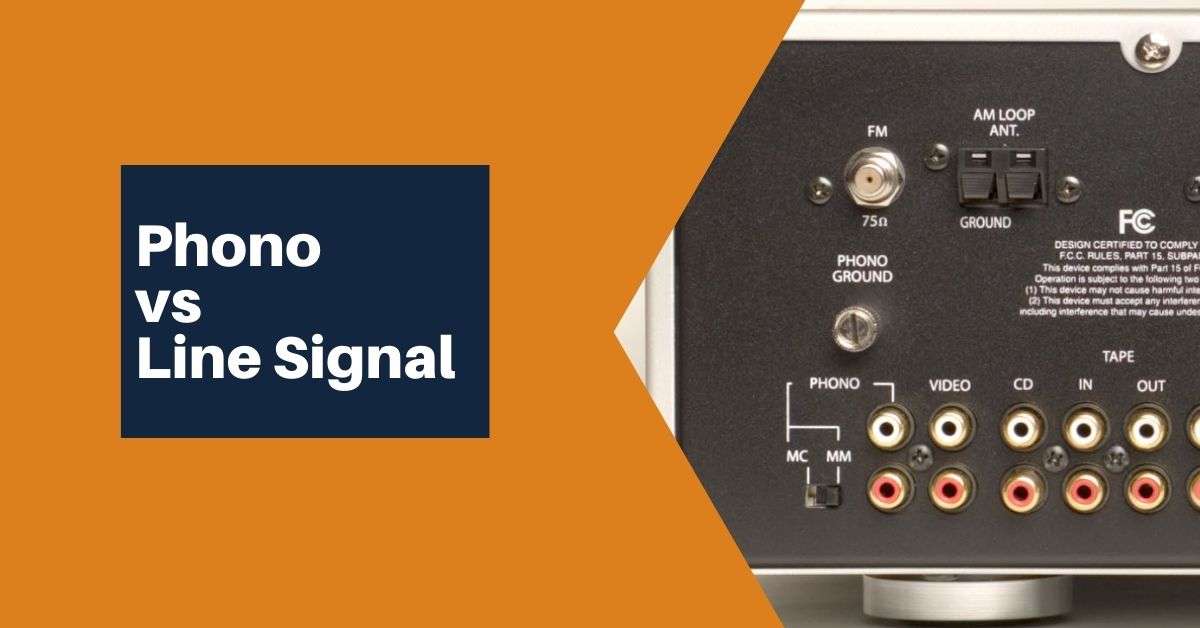The common misunderstanding between Line and Phono confuses both new turntable users as well as experienced ones. Within this page, we’ll the differences between the two inputs and why or how you might use one plug over the other.
For further reading about turntables as a whole, check out our turntable setup guide.
What’s the Difference between Phono and Line?

The primary difference between Phono and Line is that a Phono signal is much weaker than a Line signal. A Phono output signal needs the help of a preamp in order to properly amplify the sound. That’s why Phono level audio sounds much quieter.
Line level is audio output that’s already been amplified. Line level comes from many different devices such as a CD player, phone, or laptop. If you plug a device producing a line signal, you’ll notice heavy distortion and horrible sound quality. This is because you’re amplifying an already amplified signal.
What to do with Phono Output?
When a turntable cartridge rides along the groove of a record, it produces a very quiet audio signal that is passed out of your turntable. This is a Phono signal. As mentioned above, this signal needs to be amplified in order to be properly heard and enjoyed. There are a few ways of amplifying this Phono signal.
Built-In Phono Preamp
Some turntables have a built-in preamp that can amplify the Phono signal before plugging into a stereo or speakers. The quality of the preamps can range from bad to good, but there is usually an option to turn off or bypass any preamp built into a turntable.
Keep in mind, if you elect to use the built-in preamp, you do not need to plug your turntable into your stereo or speaker’s Phono input. Instead, plug into the line or tape channel to access the non-amplified, line input. If you do end up doing this, you’ll realize shortly as the sound quality of your music will be very distorted. Simple either switch your preamp off or swap your cables from the Phono channel to a Line channel.
External Phono Preamps
If your turntable and stereo do not have built-in preamps, purchasing an external Phono preamp might be the way to go. These devices work to amplify the Phono signal, enabling you to connect to any line channel on your stereo or speakers.
Again, like mentioned above, be sure you’re only using one form of amplification, otherwise, your sound will be distorted. Generally, it’s best to use a standalone Phono preamp if you have one rather than a built-in one or a Phono input channel.
How Does Phono Amplification Work?
When a cartridge rides along the grooves of a record, the sound it produces is very quiet. If you’ve ever experienced this before, you’ll notice very thin-sounding, quiet audio. This is because when a record is made, the low frequencies are reduced and the high frequencies are increased.
Why is this? The answer is fairly simple; lower bass frequencies require larger grooves to be carved into a vinyl record. Larger grooves mean less room on the vinyl record, shorter recording times, and a higher chance of a groove damaging a turntable cartridge.
In order to mitigate this, records are carved in a way that reduces the low bass tones in order to conserve space and prevent unnecessary wear and tear on the cartridge.
Now, obviously, this has to be corrected somehow. That’s where the amplification and equalization come in through a process called RIAA Equalization.
What is RIAA Equalization?
RIAA equalization was established by the Recording Industry Association of America in order to increase vinyl recording time, improve sound quality, and protects against damage to turntable cartridges during playback.
RIAA equalization involves amplifying the previously reduced bass signal while also reducing the high frequencies coming from the vinyl record. The amplification can be done through the use of vacuum tubes or electrical transistors in tube preamps or solid-state preamps respectively. This creates results in a balanced audio signal ready to be listened to and enjoyed!
Conclusion
By now, you should know the differences between a Phono and Line signal.
To recap, the Phono signal coming from your turntable is much quieter than the amplified, Line version. You must amplify this Phono signal to be able to properly enjoy it. Some turntables have this feature built-in, others do not.
Also worth noting that record players do not need any preamps to play audio. Find out more about the differences between turntables and record players here.
A line signal is the typical audio your used to listening to. It’s an amplified output that sounds balanced and equalized.
Lastly, we discussed RIAA Equalization and how it works to boost and reduce certain frequencies that come from the turntable phono signal.
Interested in a preamp of your own? Check out our phono preamp buyer’s guide!

Lead Editor / Owner
After beginning his career in the video and audio recording industry, Andrew started HiFi Hippo to share his knowledge and passion for vinyl and vintage audio with other readers.
